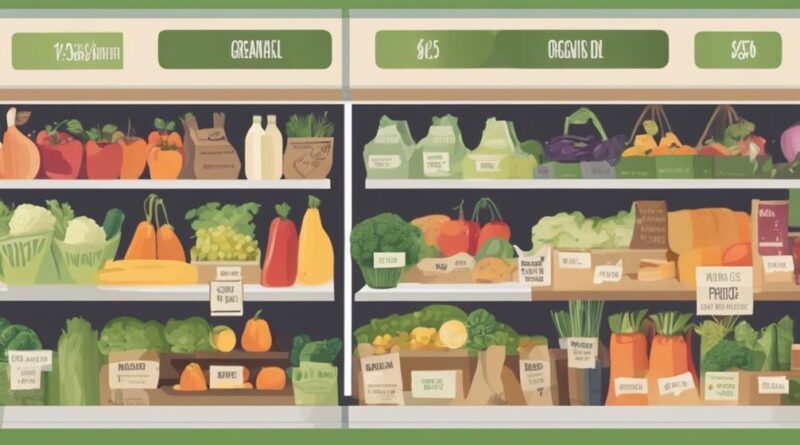Understanding Consumer Views on Organic Food Costs
When considering organic food costs, various factors come into play—like production expenses and consumer demand. Factors such as supply chain efficiency and market competition affect final prices. Consumers weigh perceived benefits and affordability when deciding to pay more for organic products. Budget constraints and seeking alternatives can influence purchasing decisions. Perceived health benefits and environmental impact drive consumer preferences for organic foods. Marketing strategies emphasize quality, health benefits, and environmental considerations which influence pricing. By understanding these dynamics, one gains insight into why consumers evaluate organic food costs the way they do.
Rising Organic Food Price Concerns
Consumers are increasingly expressing apprehension over the escalating costs of organic food in today's market. Various factors contribute to these concerns, including consumer perceptions, affordability challenges, market trends, and price fluctuations.
Consumer perceptions play a crucial role in shaping views on organic food costs. Many consumers believe that organic food is healthier and more environmentally friendly, leading to a higher willingness to pay a premium for these products. However, as prices continue to rise, affordability challenges arise, causing some consumers to reconsider their purchasing decisions. This shift in consumer sentiment can impact the demand for organic products, influencing market dynamics.
Market trends also contribute to the rising costs of organic food. The growing demand for organic products has led to an expansion of the market, attracting more suppliers. However, this increased competition doesn't always result in lower prices for consumers. Price fluctuations in the organic food market can be influenced by various factors, such as weather conditions affecting crop yields, transportation costs, and production expenses.
Factors Influencing Organic Food Costs
Amidst the complex organic food market landscape, various factors intricately interact to influence the costs of organic products. Understanding these factors is crucial for comprehending the pricing dynamics of organic food items.
- Supply Chain: The organic food supply chain plays a pivotal role in determining the final cost of organic products. Factors such as organic certification requirements, limited availability of organic inputs, and higher production costs contribute to the overall expenses incurred by producers, which are then passed on to consumers.
- Consumer Demand: The level of consumer demand for organic food also significantly impacts its pricing. As more consumers shift towards organic products due to health and environmental concerns, the increased demand can lead to higher prices, especially if supply struggles to keep pace. This surge in demand can trigger a supply-demand imbalance, further influencing the pricing structure.
- Market Competition: The competitive landscape within the organic food sector can affect pricing strategies. Intense competition among organic food producers and retailers can lead to price wars or price stabilization efforts, ultimately impacting the costs borne by consumers. Additionally, market trends, global economic conditions, and regulatory changes can all influence the pricing of organic food products.
Consumer Willingness to Pay More
The willingness of consumers to pay more for organic food is influenced by various factors such as perceived benefits, economic considerations, and product availability. Understanding consumer preferences is crucial in determining the price sensitivity towards organic products. Consumer preferences encompass a range of factors including health consciousness, environmental concerns, and ethical considerations. These preferences play a significant role in shaping the demand for organic food and the willingness to pay a premium for it.
Price sensitivity is another key aspect when analyzing consumer willingness to pay more for organic food. While some consumers prioritize the perceived benefits of organic food regardless of the price, others are more price-sensitive and may only opt for organic products if the price difference is within a certain range. Studies have shown that consumer segments exist within the organic food market, with some willing to pay a higher premium for certified organic products, while others may only consider purchasing organic items when they're competitively priced with conventional alternatives.
Therefore, companies in the organic food industry need to understand these nuances in consumer behavior to effectively market their products. By catering to different consumer segments based on their preferences and price sensitivity, businesses can better meet the diverse demands within the organic food market and potentially increase consumer willingness to pay more for organic products.
Perceived Benefits of Organic Food
When considering organic food, one may observe a myriad of perceived benefits that influence consumer choices and purchasing behavior. Consumers often prioritize organic products due to the perceived health benefits and positive environmental impact associated with them.
- Health Benefits:
- Organic food is often perceived as healthier due to the absence of synthetic pesticides, hormones, and antibiotics commonly found in conventional products. Consumers believe that organic food is more nutritious and safer for consumption, leading to a preference for these items.
- Environmental Impact:
- The environmental benefits of organic farming practices, such as reduced chemical pollution and soil preservation, appeal to environmentally conscious consumers. Choosing organic is seen as a way to support sustainable agricultural methods that prioritize soil health and biodiversity.
- Sustainability:
- Many consumers view organic food as a more sustainable option compared to conventionally grown produce. The emphasis on practices that promote long-term environmental sustainability, such as crop rotation and composting, aligns with the values of individuals seeking to minimize their ecological footprint through their food choices.
These perceived benefits play a significant role in shaping consumer perceptions of organic food and drive purchasing decisions. Understanding these factors can provide valuable insights into consumer behavior and preferences regarding organic products.
Budget Constraints on Organic Purchases
Considering the financial constraints that impact consumers, purchasing organic food can pose a significant challenge despite its perceived benefits. Affordability challenges often lead consumers to weigh their options carefully when it comes to buying organic products. Many consumers are faced with the dilemma of wanting to opt for organic options due to health and environmental considerations but are constrained by their budgets. This situation prompts individuals to make critical consumer choices regarding their purchases.
To address the budget constraints on organic purchases, consumers often seek out budget-friendly alternatives. One common strategy is to prioritize which organic products to buy, focusing on items where the organic label makes a more significant impact. For example, prioritizing organic fruits and vegetables known to have higher pesticide residues when conventionally grown can be a strategic choice. This way, consumers can still benefit from organic options while managing their expenses effectively.
Moreover, when faced with budget limitations, consumers may explore different avenues to access organic products at more reasonable prices. This could involve buying in bulk, opting for store brands, or shopping at local farmers' markets where prices for organic produce may be more competitive. By being proactive and exploring these budget-friendly alternatives, consumers can strike a balance between their desire for organic options and their financial constraints.
Price Vs. Quality in Organic Products
Given the financial limitations influencing consumer choices, evaluating the balance between price and quality in organic products becomes paramount. When considering organic products, consumers often weigh the cost against the perceived quality to determine the value proposition. Here are some key points to consider:
- Cost Comparison: Consumers frequently compare the prices of organic products with their non-organic counterparts. This comparison is crucial in determining whether the premium paid for organic products aligns with the perceived benefits in terms of quality and health aspects.
- Value Proposition: The value proposition of organic products lies in the perceived quality, health benefits, and environmental impact. Consumers assess whether the higher price of organic products is justified by the perceived value they receive in return.
- Consumer Perception: Understanding consumer perception plays a vital role in the price versus quality evaluation. Consumers may be willing to pay a higher price for organic products if they believe in the superior quality, ethical production methods, and environmental sustainability associated with these products.
Marketing Strategies Impacting Organic Pricing

Marketing strategies significantly impact the pricing of organic products in today's competitive market landscape. Companies employ various pricing strategies to position their organic goods effectively amidst market competition. One common approach is premium pricing, where products are priced higher to convey a sense of exclusivity and quality. This strategy is often used by organic brands that have established a strong reputation for superior products and cater to a niche market segment willing to pay a premium for perceived value.
On the other hand, some companies opt for penetration pricing to gain market share quickly. By pricing organic products lower than competitors, businesses can attract price-sensitive consumers and potentially build brand loyalty over time. However, this strategy may not be sustainable in the long run if it leads to pricing wars or compromises the perceived value of the organic products.
Dynamic pricing strategies are also prevalent in the organic food industry, where prices fluctuate based on demand, seasonality, or other market factors. By leveraging data analytics and real-time market insights, companies can optimize pricing to maximize revenue while remaining competitive.
Future Trends in Organic Food Pricing
Future trends indicate a shift towards personalized pricing strategies in the organic food industry. As consumer behavior and concerns over sustainability continue to shape the market, organic food pricing strategies are evolving to meet these demands. Price fluctuations are becoming more common as companies seek to balance affordability with maintaining sustainable practices. Understanding consumer behavior is crucial in determining the effectiveness of these pricing strategies.
Dynamic Pricing Models: Companies are increasingly adopting dynamic pricing models that allow for real-time adjustments based on factors such as demand, seasonality, and production costs.
Subscription-Based Services: Some organic food providers are moving towards subscription-based services, offering consumers the convenience of regular deliveries at fixed prices while ensuring a steady revenue stream for the company.
Transparency in Pricing: With the growing emphasis on sustainability, consumers are demanding greater transparency in pricing. Companies are responding by providing detailed breakdowns of pricing to showcase the value of organic products.
These trends highlight the complex interplay between price fluctuations, consumer behavior, sustainability, and pricing strategies in the organic food industry. By embracing these changes and adapting pricing strategies to align with consumer preferences, companies can navigate the evolving landscape of organic food pricing successfully.
Conclusion
In conclusion, understanding consumer views on organic food costs is crucial for businesses looking to capitalize on this growing market. Rising concerns about price, factors influencing costs, and consumer willingness to pay more all play a significant role in shaping the organic food industry.
By considering the perceived benefits, budget constraints, and the balance between price and quality, businesses can develop effective marketing strategies to meet consumer demands while maintaining profitability. Keeping an eye on future trends in organic food pricing will be essential for success in this competitive market.
